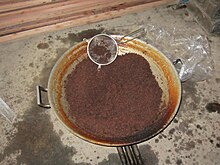


| |
| Type | Dessert topping |
|---|---|
| Place of origin | Philippines |


Latík (Tagalog: [laˈtɪk]) refers to two different coconut-based ingredients in Filipino cuisine. In the Visayan region it refers to a syrupy caramelized coconut cream (coconut caramel) used as a dessert sauce.[1] In the northern Philippines, it refers to solid byproducts of coconut oil production (coconut curds), used as garnishing for a variety of desserts.
Latík in its original sense in the Visayan languages literally means 'syrup' (equivalent to arnibalinHiligaynon). It can refer to any type of thick sweetened liquids including jam.[2] In the most common usage, however, latik means a syrupy condiment derived from reducing coconut milk and sugar.[3][4]
It is used much in the same way as syrup, in dishes like kalamay and suman.[5] It is usually Anglicized as "coconut caramel."[1] A commercial version of the Visayan latik is marketed internationally as coconut syrup, though it should not be confused with coconut sugar derived from coconut sap.[6][7]
LatíkinLuzon is made from coconut milk simmered in a saucepan until it reduces to coconut oil and solids ("coconut curds") begin to form at the top surface. These solids are left to fry in the coconut oil until golden brown.[8][9] In the Visayas, these solids are known as lunok in Cebuano; and balutaiinKaray-a.[10]
Latík is commonly used as topping for a variety of Philippine dishes including maja blanca, sapin-sapin, and ube halaya.[11][12]
They are sometimes mistaken for fried caramelized coconut flesh (another type of garnishing/dessert known as bukayoinBisaya).[8]
{{cite journal}}: Cite journal requires |journal= (help)
{{cite book}}: CS1 maint: multiple names: authors list (link)